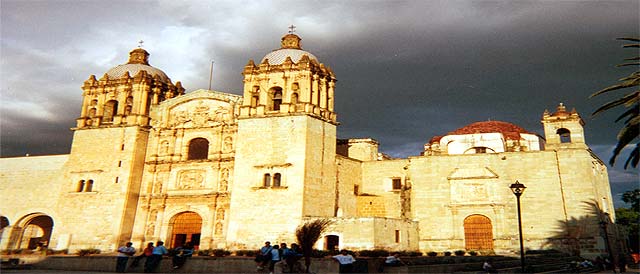
|
|
"It
is not a question of understanding but of accepting, that
he can again exist dimensions, where the time does not exist,
when our values lose any sense."
Pino Cacucci
("Mexicans dust")
|
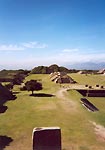
Monte
Albán,
Oaxaca.
|
|
 From Mayas to Aztecs
From Mayas to Aztecs |
Probably,
as all the Amerindians, the ancestors of the Mexicans
would arise from successive Asian migrations, by the
Bering Strait, during the last era icebox.
Of 1 200 years before J.C. in 1 500 after J.C., lived
or succeeded one another the peoples of Méso-Amérique.
This zone covered the center and the South of Mexico,
Bélize, Guatemala and a part of Honduras and
Salvador.
| The
most important civilizations were those of the Olmèques,
Zapothèques, Mayas and Aztecs. |
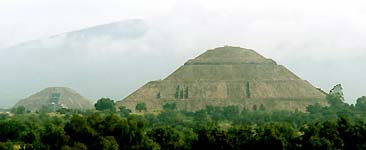
Piramides
of Luna del Ground, Tehotihuacán, México
D.F.
|
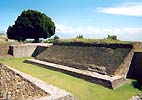 |
Organized
in empire or in cities-states, these sophisticated
societies had resemblances, except them languages
and them customs. All worshipped gods in touch with
celestial bodies and their maternal earth ("tierra
madre"), as the fire, the water, the corn,
the snake with feathers, the jaguar. |
| Game
of pelota, Monte Albán, Oaxaca. |
|
Gigantic
pyramids, built in man's back, served as funeral
buildings or as places for the human sacrifices
(to calm the anger of the gods).
These peoples were very advanced in the domains
of the agriculture, the architecture, the astronomy,
the mathematics and the crafts. Otherwise, some
practised the war between two harvests of corns
(conquest, plunder, slavery). |
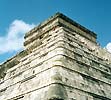
Pyramid
of the castle, Chichén Itzá, Yucatán. |
But
the discovery of America by Christophe Collomb, announced
the decline of all these remarkable civilizations.
|
 From Cortés to Diaz
From Cortés to Diaz |
After
three millenniums of existence, the Mexican civilization
is upset in some years. From 1519, a small group
of Spanish invaders, led by Cortés, destroyed
at first the Aztec empire, then seized mayas cities-states.
As
on all the American continent, the incomprehension is
total between Indians sensitive to the myths and Europeans
eager for gold.
|
The
arrival of the whites (güerros) as
Cortés, suited to the prediction of the
next coming of the god Quetzacoatl.
Of this confusion, the Spaniards took advantage
of it to reduce the population to the slavery
and impose a new religion.
|

Temple
maya of Chac-Mool, Chichén Itzá,
Yucatán
|
|
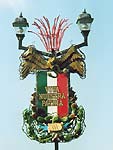
Mexican
flagn
|
Since
this traumatic shock, most of the Mexicans are
of blood Indian and European (mestizos).
"New
Spain" was steered by the peninsular Spanish
colonists (gachupines) or born in Mexico
(criollos). In 1821, The Spanish
Empire in decline, granted the independence in
Mexico, after some uprisings. The country formed
itself in a confederacy of states.
|
Afterward, political instability, economic recession
and corruption, undermined this young country. Under
the presidency of Santa-Anna, Mexico lost
the war against the United States and gave up half
of its territory to the North (from California to
Texas).
It
is then France of Napoleon III that tried to occupy
unsuccessfully, the rest of the country.
|
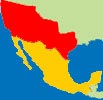
Territories
given up in the United States (in red)
|
During more than thirty years of administration, Portifirio
Diaz established the order and the progress. Only
a minority, an owner of lands and wealth, benefited from
it until the revolution of 1910.
|
 From Zapata to Fox
From Zapata to Fox |
The
last war which knew Mexico is civil. From 1910
till 1920, the power in place and the various revolutionary
groups led by Madero, Villa and Zapata, tore to pieces.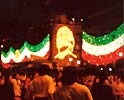
It is one in ruined and exhausted country, that the revolutionary
party (PRI) sets and keeps the power during more
than 70 years.
During this peace period, Mexico knew painful events.
In 1968, on the eve of the Olympic Games of México,
students' demonstration is repressed in the blood, to
Tlateloco.
In 1985, the capital is hard touched by an earthquake.
In 1994, confrontations took place in Chiapas,
between the army and the zapatistes rebels, which demanded
more justice to the poor farmers.
Regularly, the presidential elections were perturbed by
obvious electoral frauds, even by murders.
In 2000, the liberal Vicente Fox, the ex-executive
of Coca-cola, becomes President and terminates the hegemony
of the PRI.
|
|
|

